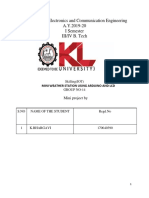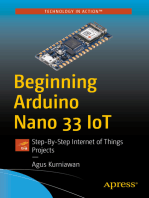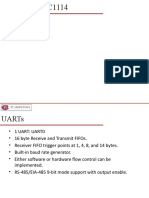Practical File
Practical File
Uploaded by
ravishku2403Copyright:
Available Formats
Practical File
Practical File
Uploaded by
ravishku2403Original Title
Copyright
Available Formats
Share this document
Did you find this document useful?
Is this content inappropriate?
Copyright:
Available Formats
Practical File
Practical File
Uploaded by
ravishku2403Copyright:
Available Formats
PRACTICAL FILE
Student Name ANANYA
UID 21BCS2594
Section & Group 21BCS_IOT_612 - A
Department Computer Science & Engineering
Session July-Dec 2023
Course Name Internet of Things Lab
Course Code 21CSP-344
Semester 5th
Department of Computer Science & Engineering
Chandigarh University, Mohali
INDEX
S. No. Experiment Date Conduct Viva Worksheet Total Remarks
(12) (10) (8) (30)
1 Experiment 1.1: To Assemble
Arduino Uno with the system
and perform necessary
software installation.
2 Experiment 1.2: Selection of
different IoT sensors in
different sectors.
3 Experiment 1.3: Design LCD
interfacing on WOKWI or
Any Simulation Platform.
4 Experiment 1.4: Develop a
smart traffic light management
system with the help of IoT.
5 Experiment 2.1: Formulate
distance of an object using an
ultrasonic sensor.
6 Experiment 2.2: To
investigate real-time
relationship between
humidity and temperature in
IoT.
7 Experiment 2.3: Assemble and
Controlling of multiple
actuators using Arduino Uno
for any IoT Application.
8 Experiment 3.1: To design a
weather station by checking
Air quality of an environment
with the help of IoT.
9 Experiment 3.2: Case study of
Agriculture 4.0 using IoT and
to develop an IoT model for
the agriculture sector.
10 Experiment 3.3: To create a
smart home project, using
App based control system.
Course Name: Internet of Things Lab Course code: 21CSP-344
Experiment1.1
Student Name: Ananya UID: 21BCS2594
Branch: CSE Section/Group: 612-A
Semester: 5th Date of Performance:9th Aug 2023
Subject Name: Internet Of Things Lab Subject Code: 21CSP-358
Aim:
To Assemble Arduino Uno with the system and perform necessary software installation.
Objectives:
1. To study hardware and software related to IoT.
2. To gain an understanding of the role and operation of the Arduino Uno.
Components Used:
Arduino Uno
Description:
The Arduino Uno, a popular microcontroller board, is a versatile platform for creating
interactive electronic projects. Its design features several important pins and a structured layout
that make it suitable for a wide range of applications:
Important Pins:
i. Digital I/O Pins (D2-D13): These pins serve as versatile inputs and outputs, allowing you
to interact with the digital world by reading sensors or controlling devices like LEDs and
motors.
ii. Analog Input Pins (A0-A5): These pins enable the measurement of analog signals from
sensors, facilitating tasks such as monitoring light levels or temperature.
Name: Sindhant Kumar UID: 21BCS2625
Course Name: Internet of Things Lab Course code: 21CSP-344
iii. PWM Pins (D3, D5, D6, D9, D10, D11): Supporting Pulse Width Modulation, these pins
create analog-like signals for applications like motor speed control and LED fading.
iv. TX and RX (D0 and D1): Used for serial communication, these pins facilitate interaction
between the Arduino and other devices, such as computers or microcontrollers.
v. Reset (RESET): The reset pin restarts the microcontroller, reinitializing program
execution.
vi. 5V and 3.3V Pins: These regulated voltage outputs power external components, ensuring
consistent performance. vii. Ground (GND): Vital as a reference point in circuits, ground
pins connect to external components for proper functionality. viii. Vin (Voltage In):
Accepting external power (7-12V), this pin supplies energy to the Arduino.
ix. AREF (Analog Reference): Serving as an external reference voltage for analog-to- digital
conversion, AREF enhances measurement accuracy.
x. I2C Pins (A4, A5): I2C communication pins connect to various devices like sensors and
displays, expanding project capabilities.
xi. SPI Pins (D10, D11, D12, D13): Serial Peripheral Interface pins facilitate
communication with devices like SD cards and other microcontrollers.
xii. Crystal Oscillator Pins (XTAL1, XTAL2): Connectable to an external crystal oscillator,
these pins ensure precise timing.
Name: Sindhant Kumar UID: 21BCS2625
Course Name: Internet of Things Lab Course code: 21CSP-344
Structure Overview:
i. Microcontroller: Powered by the ATmega328P microcontroller, clocked at 16MHz,
executing program instructions. ii. Memory: With 32KB Flash for program storage, 2KB
SRAM for variables, and 1KB EEPROM for non-volatile data. iii. Voltage Regulation: The
onboard voltage regulator converts external power (7-12V) to a stable 5V for the
microcontroller.
iv. USB Interface: Enabling programming and serial communication with computers,
enhancing project interaction.
v. Bootloader: Pre-loaded for easy programming without an external programmer,
simplifying the development process.
vi. Headers and Connectors: Supporting power, ground, digital, and analog I/O pins, allow
easy connections to various components.
Installing the Arduino IDE:
i. Download: Visit the official Arduino website and download the IDE for your operating
system (Windows, macOS, or Linux).
ii. Run Installer: Open the downloaded file and follow the installation prompts.
Name: Sindhant Kumar UID: 21BCS2625
Course Name: Internet of Things Lab Course code: 21CSP-344
iii. Choose Location: Select the installation location for the IDE on your computer.
iv. Driver Installation (Windows Only): If using Windows, some boards might require
drivers. Follow the provided instructions to install them.
v. Launch IDE: Once installed, open the Arduino IDE.
vi. Board: From the Tools menu, choose the appropriate Arduino board model.
vii. Select Port: Also in the Tools menu, select the correct serial port your Arduino board is
connected to.
viii. Verify Installation: Write a simple program, upload it to the board, and observe the results
to confirm successful installation.
ix. Start Creating: Begin crafting your Arduino projects by writing sketches and
experimenting with the platform.
Name: Sindhant Kumar UID: 21BCS2625
You might also like
- MAR Lab Manual 1 2Document31 pagesMAR Lab Manual 1 2Sujal PatilNo ratings yet
- Ctrack Nx50.40 Technical and User Manual: Digicore Technology (Pty) LTDDocument48 pagesCtrack Nx50.40 Technical and User Manual: Digicore Technology (Pty) LTDMiswantoNo ratings yet
- Amazon Case StudyDocument16 pagesAmazon Case StudyGaurav ChauhanNo ratings yet
- Activity 1 Embedded Technology Team 4Document5 pagesActivity 1 Embedded Technology Team 4Aljiven AlejoNo ratings yet
- Interactive Monitoring and Controlling System ForDocument5 pagesInteractive Monitoring and Controlling System ForSchields PedroNo ratings yet
- IOT Exp 1 & 2Document2 pagesIOT Exp 1 & 2Legend YTNo ratings yet
- (123doc) Asm 2 Iot 1690 FPT Greenwich Merit Good ChoiceDocument22 pages(123doc) Asm 2 Iot 1690 FPT Greenwich Merit Good ChoiceTa Minh Anh (FGW HN)No ratings yet
- Lab - Manual - Iot 22Document35 pagesLab - Manual - Iot 22The KevinNo ratings yet
- Home Automation Based On Wireless Communication: II. Literature ReviewDocument6 pagesHome Automation Based On Wireless Communication: II. Literature ReviewJOIJODE VRUSHABHNo ratings yet
- IoT Applications Lab Manual ITDocument45 pagesIoT Applications Lab Manual ITAwanit KumarNo ratings yet
- Activity No 1-bDocument5 pagesActivity No 1-bAljiven AlejoNo ratings yet
- Iot WorkshopDocument13 pagesIot WorkshopJOTHI M CSBS FACULTYNo ratings yet
- ElectricalDocument4 pagesElectricalRahul RockyNo ratings yet
- Embedded Lab: Arduino Projects in Science LessonsDocument6 pagesEmbedded Lab: Arduino Projects in Science LessonskhalidNo ratings yet
- JETIR2405179Document6 pagesJETIR2405179Dr.D. Narendar SinghNo ratings yet
- IoT Applications Lab Manual IT1Document39 pagesIoT Applications Lab Manual IT1Swasti Sundar TiwariNo ratings yet
- Electrical Energy Monitoring and Home Automation Using IoTDocument4 pagesElectrical Energy Monitoring and Home Automation Using IoTInternational Journal of Innovative Science and Research TechnologyNo ratings yet
- Set A - Notes - Iot - 3rd UnitDocument212 pagesSet A - Notes - Iot - 3rd Unitsauravchoudhary756No ratings yet
- Iot& WSN Module-3Document82 pagesIot& WSN Module-3Darshan GowdaNo ratings yet
- Iot Based Smart Solar Street Light Battery/Panel Fault DetectionDocument6 pagesIot Based Smart Solar Street Light Battery/Panel Fault DetectionEmmanuel AjibolaNo ratings yet
- Iot Lab Manual Khushi GondDocument57 pagesIot Lab Manual Khushi Gondkhushi GondNo ratings yet
- Dam Monitoring SystemDocument43 pagesDam Monitoring SystemRoshan MNo ratings yet
- Manual Internet of Things IDocument60 pagesManual Internet of Things ImobilecomputingNo ratings yet
- Low Cost Iot System For Solar Panel Power Monitoring: June 2019Document6 pagesLow Cost Iot System For Solar Panel Power Monitoring: June 2019mauroalmeNo ratings yet
- Iot ProjectDocument13 pagesIot ProjectshriyansarahNo ratings yet
- 22222Document16 pages22222المصور الدائريNo ratings yet
- University Institute of Engineering Department of Computer Science & EngineeringDocument7 pagesUniversity Institute of Engineering Department of Computer Science & EngineeringPratik MishraNo ratings yet
- Main PDFDocument35 pagesMain PDFRamu50% (2)
- 642a198e14a77IOT Lab2 Spring2023Document14 pages642a198e14a77IOT Lab2 Spring2023waseem cryptoNo ratings yet
- Report Door LockDocument20 pagesReport Door Lockdhruva yadavNo ratings yet
- Review On Different Microcontroller Boards Used in IoTDocument11 pagesReview On Different Microcontroller Boards Used in IoTIJRASETPublicationsNo ratings yet
- Harsh PatilDocument20 pagesHarsh Patilsanhita koliNo ratings yet
- Group 13 Weather PredictionDocument43 pagesGroup 13 Weather Predictionanassaif.507No ratings yet
- Electronic Fingerprint SafeDocument10 pagesElectronic Fingerprint Safe5017Krishna Prasanth TMCTNo ratings yet
- Node Mcu NotesDocument3 pagesNode Mcu NotesIftekhar AlamNo ratings yet
- Voice Based E-Notice Board Using AndroidDocument9 pagesVoice Based E-Notice Board Using Androidgoutham p100% (1)
- Lab 9-MPMCDocument20 pagesLab 9-MPMCShehwar Tanveer 860-FET/BSEE/F20No ratings yet
- DMV & ML LabDocument31 pagesDMV & ML Labshindeprathamesh7768No ratings yet
- Iot FileDocument84 pagesIot Fileyifiv89653No ratings yet
- 02 - IoT HardwareDocument12 pages02 - IoT HardwaremanthanstdNo ratings yet
- Fundamentals of IoT (43460703)Document8 pagesFundamentals of IoT (43460703)Darshan NakumNo ratings yet
- IOT Lab - PDF FinalDocument33 pagesIOT Lab - PDF FinalsourabhediterNo ratings yet
- Summer Training On ArduinoDocument52 pagesSummer Training On ArduinoAakritiNo ratings yet
- SKD Report IotDocument19 pagesSKD Report IotmaheshNo ratings yet
- Darshit 1.3Document2 pagesDarshit 1.3darshitsheth136No ratings yet
- Obot Ontrolled AR Using Wireless Module: Eminar Presentation ONDocument24 pagesObot Ontrolled AR Using Wireless Module: Eminar Presentation ONvenkateshNo ratings yet
- Government Polytechnic, Washim: Mr. U. A. Bagade K. V. IngoleDocument14 pagesGovernment Polytechnic, Washim: Mr. U. A. Bagade K. V. Ingolesandeshlahane901No ratings yet
- Energy Management Control System W3Document15 pagesEnergy Management Control System W3Jerico GallegoNo ratings yet
- Io TDocument19 pagesIo TAchmad Fahrul Aji100% (2)
- Kids Can Code Program Arduino Programming For Beginners Date: Saturday 29 May 2021 Venue: Ericsson Lab, @ilabafricaDocument1 pageKids Can Code Program Arduino Programming For Beginners Date: Saturday 29 May 2021 Venue: Ericsson Lab, @ilabafricaJeff MianoNo ratings yet
- Iot MajrrDocument25 pagesIot MajrrSrinivas ReddyNo ratings yet
- Lab 1Document4 pagesLab 1HALIMANo ratings yet
- Bluetooth Remote Controlled Car Using ArDocument4 pagesBluetooth Remote Controlled Car Using ArErnest ChiwaleNo ratings yet
- School EntranceDocument16 pagesSchool Entrancerodneynaga16No ratings yet
- ES Lab ManualDocument117 pagesES Lab ManualSri JalakamNo ratings yet
- Final Project ReportDocument149 pagesFinal Project ReportshaktiNo ratings yet
- Labview + AurdinoDocument4 pagesLabview + AurdinoRahul Virmani0% (1)
- Final Report Embedded System UpdatedDocument17 pagesFinal Report Embedded System UpdatedHassan AlsafiNo ratings yet
- WEEK 4 2nd SEM DLL-EPAS12 MAJOR 7 & 8 Feb 19 - 23, 2024Document8 pagesWEEK 4 2nd SEM DLL-EPAS12 MAJOR 7 & 8 Feb 19 - 23, 2024adonis.santiagoNo ratings yet
- Iot Based Humidity and Temperature Monitoring Using Arduino UnoDocument5 pagesIot Based Humidity and Temperature Monitoring Using Arduino Unoanandsiva2009No ratings yet
- Home Automation SystemDocument30 pagesHome Automation System666 TarotNo ratings yet
- Beginning Arduino Nano 33 IoT: Step-By-Step Internet of Things ProjectsFrom EverandBeginning Arduino Nano 33 IoT: Step-By-Step Internet of Things ProjectsNo ratings yet
- Ai Unit 4Document41 pagesAi Unit 4Vijesh gNo ratings yet
- of MP (Banking REcord SystemDocument38 pagesof MP (Banking REcord SystemAjit TiwariNo ratings yet
- PT VX610Document6 pagesPT VX610reedNo ratings yet
- Cover Letter: TO: From: Emranullah NasiriDocument4 pagesCover Letter: TO: From: Emranullah NasiriEmranullah NasiriNo ratings yet
- Welcome To The 20's by SlidesgoDocument50 pagesWelcome To The 20's by SlidesgoAllison Villagomez MuñozNo ratings yet
- PDF Kamilo: Citado Por 110 Artículos Relacionados Las 4 VersionesDocument2 pagesPDF Kamilo: Citado Por 110 Artículos Relacionados Las 4 VersionesPapeleria NNo ratings yet
- VisaBoard Profile - CompressedDocument7 pagesVisaBoard Profile - CompressedexploregyanfundaNo ratings yet
- We STEAL ALIEN TechnologyDocument11 pagesWe STEAL ALIEN TechnologyRayendra RiginNo ratings yet
- Secret-Key Encryption LabDocument7 pagesSecret-Key Encryption LabReveng EngNo ratings yet
- Windows Server AdministrationDocument27 pagesWindows Server AdministrationPatricia AnnNo ratings yet
- Lecture 15 - UARTs On LPC1114Document23 pagesLecture 15 - UARTs On LPC1114Suhaib AbugderaNo ratings yet
- RIP Routing Configuration Using 3 Routers in Cisco Packet TracerDocument9 pagesRIP Routing Configuration Using 3 Routers in Cisco Packet TracerBBM SathvikNo ratings yet
- A01 Production Assurance USDocument16 pagesA01 Production Assurance USMahfoud AMMOURNo ratings yet
- Detection of Personal Attacks in Mobbing On Social Media Using Deeplearning TechniquesDocument6 pagesDetection of Personal Attacks in Mobbing On Social Media Using Deeplearning TechniquescumlicospuNo ratings yet
- Module 1 QuizDocument7 pagesModule 1 QuizKrishnanjali VuNo ratings yet
- Ip-8417 Ip-8817: Highlight InformationDocument7 pagesIp-8417 Ip-8817: Highlight InformationjuraNo ratings yet
- Implementing EHR in Nigeria: Potential Challenge and BenefitsDocument5 pagesImplementing EHR in Nigeria: Potential Challenge and BenefitsBusayo AtekoNo ratings yet
- TCI Pre-Requisite Release Wise - V1.2 1Document8 pagesTCI Pre-Requisite Release Wise - V1.2 1chindamsai.saiNo ratings yet
- DH-DVR2104/2108/2116H-V2: 4/8/16CH 2CIF Mini 1U Standalone DVRDocument3 pagesDH-DVR2104/2108/2116H-V2: 4/8/16CH 2CIF Mini 1U Standalone DVRAlvaroNo ratings yet
- Digital Logic ManualDocument14 pagesDigital Logic ManualJana Bhawana CampusNo ratings yet
- Cloud-Native-Roadmap Sample ReportDocument43 pagesCloud-Native-Roadmap Sample Reportrajutamang2021.btNo ratings yet
- 2 Unit3Document55 pages2 Unit3BrahimeNo ratings yet
- 6 Windows Internals m6 SlidesDocument14 pages6 Windows Internals m6 SlidesRon TabibianNo ratings yet
- Concrete Valve Amp V1Document17 pagesConcrete Valve Amp V1Muhammad Jalal AldeenNo ratings yet
- A Predictive Model For Road Traffic Data Analysis and Visualization To Detect Accident ZonesDocument5 pagesA Predictive Model For Road Traffic Data Analysis and Visualization To Detect Accident Zonessna.nitcNo ratings yet
- openSAP cst2 Week 2 All Slides PDFDocument72 pagesopenSAP cst2 Week 2 All Slides PDFRaul BatistaNo ratings yet
- Afzal Rashid: PakistanDocument3 pagesAfzal Rashid: PakistanIbn e AdamNo ratings yet
- US8292744B2 - Online Building Toy - Google Patents 2Document1 pageUS8292744B2 - Online Building Toy - Google Patents 2julianlee3112011No ratings yet

























































































